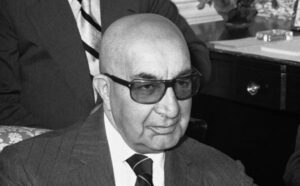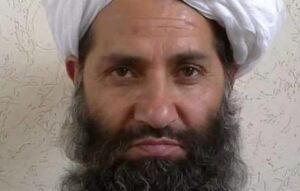| Name | Tenure | Political Party |
|---|---|---|
| Mohammed Daoud Khan | 17 July 1973 - 28 April 1978 | Independent / National Revolutionary Party |
| Colonel Abdul Qadir | 28 April 1978 - 30 April 1978 | People's Democratic Party |
| Nur Muhammad Taraki | 30 April 1978 - 14 September 1979 | People's Democratic Party |
| Hafizullah Amin | 14 September 1979 - 27 December 1979 | People's Democratic Party |
| Babrak Karmal | 27 December 1979 - 24 November 1986 | People's Democratic Party |
| Haji Mohammad Chamkani | 24 November 1986 - 30 September 1987 | Independent |
| Mohammad Najibullah | 30 September 1987 - 16 April 1992 | People's Democratic Party |
| Abdul Rahim Hatif | 16 April 1992 - 28 April 1992 | Watan Party |
| Sibghatullah Mojaddedi | 28 April 1992 - 28 June 1992 | National Liberation Front of Afghanistan |
| Burhanuddin Rabbani | 28 June 1992 - 22 December 2001 | Jamiat-e Islami |
| Hamid Karzai | 22 December 2001 - 29 September 2014 | Independent |
| Ashraf Ghani | 29 September 2014 - August 2021 | Independent |
| Mullah Mawlawi Hibatullah Akhundzada | 15 August 2021 | Taliban |
READ ALSO: Presidents That Have Ruled Iraq Till Date
First President of Afghanistan: Mohammed Daoud Khan

Mohammed Daoud Khan was the first president of Afghanistan, serving from July 17, 1973, until April 28, 1978. He was born in 1909 into the influential Barakzai dynasty, which had ruled Afghanistan for decades. Before becoming president, Daoud held various significant positions, including Prime Minister from 1953 to 1963.
Achievements and Downsides
Daoud is credited with initiating several modernization efforts in Afghanistan, focusing on infrastructure development, education, and healthcare.
His administration sought to reduce foreign influence, particularly from the Soviet Union and the United States, and aimed to establish a more independent Afghan state.
However, his tenure was marked by increasing political repression, particularly against leftist movements. His government faced significant opposition, leading to widespread unrest and ultimately the Saur Revolution, which resulted in his assassination.
READ ALSO: Presidents That Have Ruled South Korean Till Date
Note: The current individual overseeing the country is not recognized as a president but as a supreme leader of Afghanistan.
Who is the Current Supreme Leader of Afghanistan

Mullah Mawlawi Hibatullah Akhundzada, also known as Haibatullah Akhundzada, is the current supreme leader of Afghanistan under the Taliban regime. He assumed this position on August 15, 2021, following the Taliban’s takeover of the country.
Akhundzada was born in the village of Sperwan in the Panjwayi District of Kandahar Province, Afghanistan. He belongs to the Noorzai tribe and comes from a humble background. His father, Muhammad Akhund, was a religious scholar and imam at the Malook mosque in Safid Rawan village.
In the 1980s, Akhundzada was involved in the Islamist resistance against the Soviet military campaign in Afghanistan, fighting for Hezb-i Islami Khalis.
After the United States invasion of Afghanistan in 2001, he sought refuge in Pakistan and became the head of the Taliban’s shadow justice system.
Achievements
- Leadership Consolidation: He unified the Taliban after the death of Mullah Akhtar Mansour, stabilizing the organization and legitimizing his role as leader.
- Doha Agreement: Akhundzada played a crucial role in the peace talks with the United States, leading to the signing of the Doha Agreement in 2020, which facilitated the withdrawal of U.S. troops from Afghanistan.
- Military Success: Under his leadership, the Taliban executed a successful military offensive, culminating in the takeover of Kabul on August 15, 2021, while U.S. forces were still withdrawing.
- Sharia Law Implementation: He has enforced a strict interpretation of Sharia law, issuing fatwas that shape the Taliban’s legal and moral framework, although this has led to international condemnation.
- Cultural and Economic Reforms: Akhundzada has emphasized reforms aimed at creating a self-reliant Afghanistan, though these have often restricted women’s rights and freedoms.
Downsides
- Human Rights Violations: His government has been criticized for severe restrictions on women’s rights, including barring girls from secondary education.
- Reclusive Leadership Style: Akhundzada’s low public profile has raised concerns about transparency and accountability within the Taliban.
- Economic Crisis: His administration has struggled to address Afghanistan’s severe economic challenges, leading to widespread poverty and humanitarian issues.
READ ALSO: Presidents That Have Ruled Thailand Till Date
Conclusion
The history of the presidency in Afghanistan reflects a tumultuous journey marked by political upheaval, foreign intervention, and internal strife.
The ongoing situation in Afghanistan remains fluid, with the future of its governance uncertain as the country grapples with the implications of Taliban rule and the aspirations of its people for a stable and democratic state.
